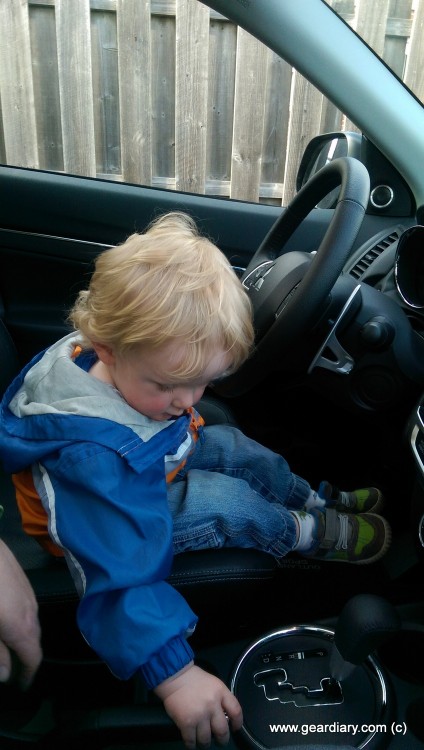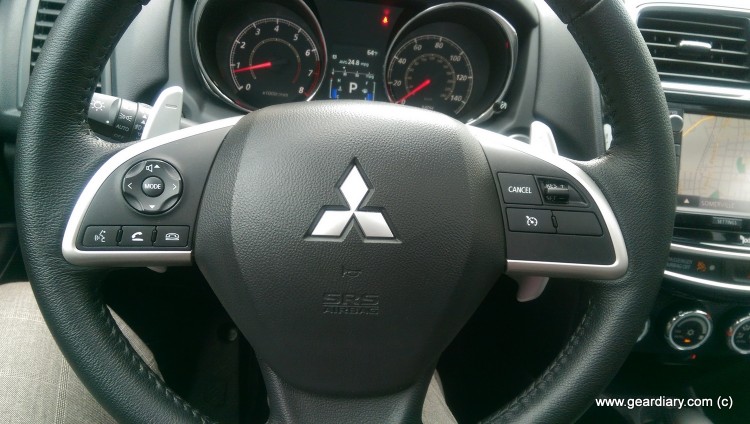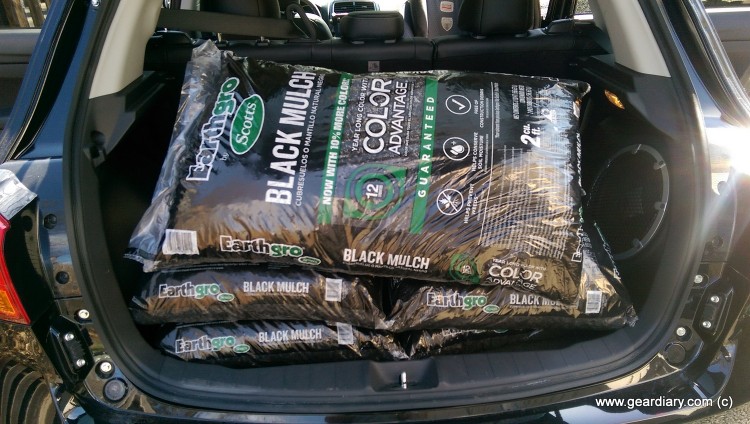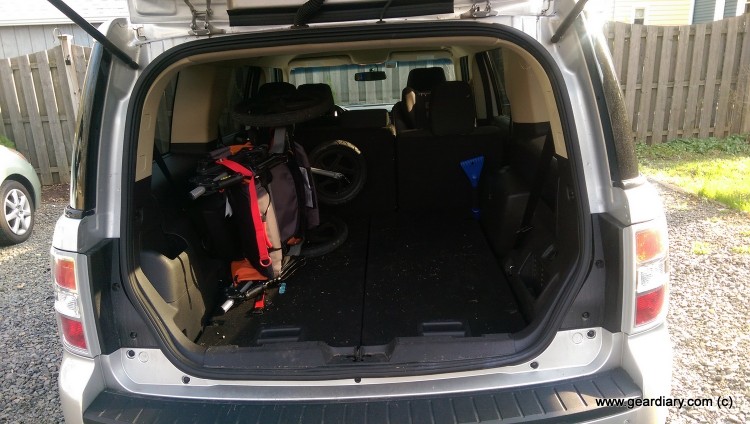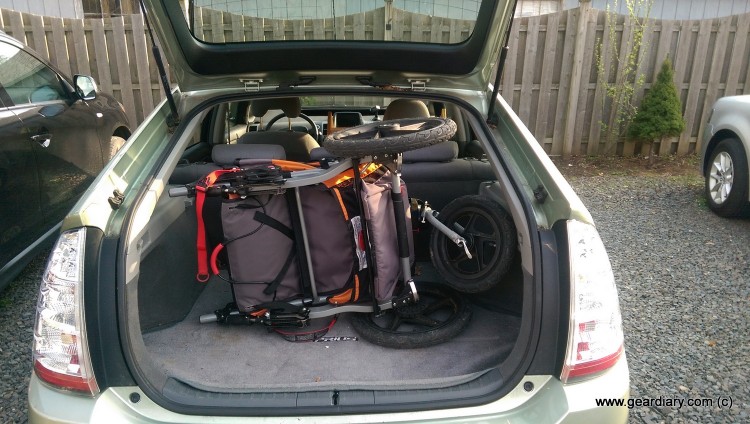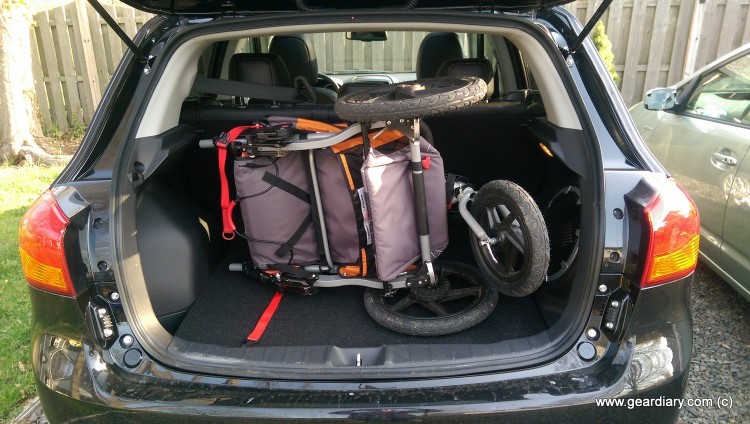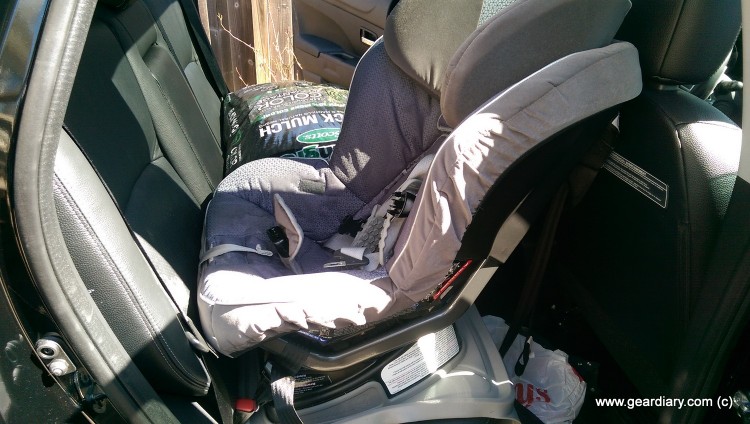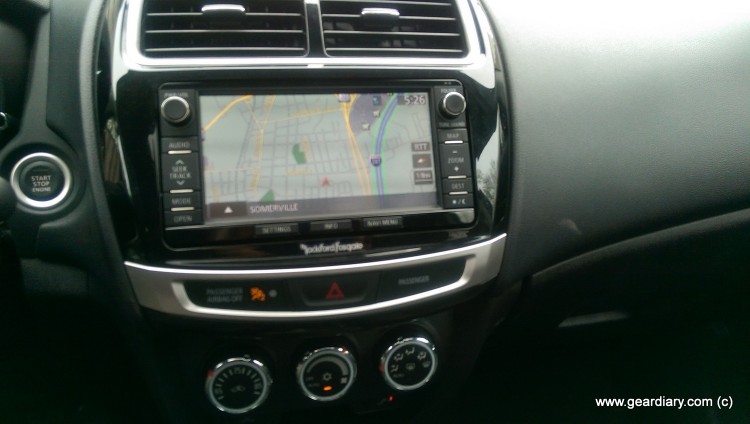I have reviewed several cars for Gear Diary, and they’re usually my favorite reviews to do. Cars are probably the biggest purchase most people make, besides a house, and they are technological tools as much as they are transportation methods. The Mitsubishi Outlander Sport excels in one of these areas and fails miserably in the other!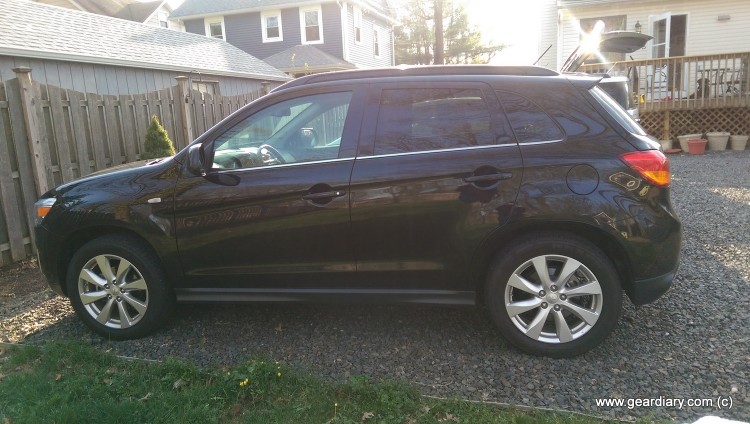
Before I get into the details of the car, here’s a glimpse of how I used it. I drive about 50 miles round trip each day for work, so I used it as my daily commuter vehicle. On the weekend, we strapped my son’s car seat in it and tried to use it as our family car for a few days. Two out of three members of my family didn’t enjoy the experience much, so I asked the one family member who clearly loved the car for a review. Unfortunately, due to limited vocabulary, all he had to share was “Car! Car! Ooooooh, caaaar. Hi Car! Bye Car!” followed by a very enthusiastic hug to the front fender. So if toddlers made car buying decisions, our next car would apparently be an Outlander Sport. Sadly for Mitsubishi, the adults in the family were not as thrilled.
(Shown: The Outlander’s biggest fan)
The car itself is actually pretty great. It feels solid and heavy, and rides fairly smoothly. I was able to test the 4 wheel drive function during a very heavy rainstorm, and while I’m reasonably confident the car would have been fine in front wheel drive, it felt very grippy and tough in 4wd, even on twisty turns and with high winds. It’s tank-like in a good way; the doors have heft to them, and they slam shut with a satisfying “clunk”. The frame and build don’t feel cheap or plasticky, so points to Mitsubishi for making a very solid feeling vehicle. That also plays out in the IIHS safety ratings, where the car scored highest marks on all but the small overlap test (where it scored the second highest mark). The Outlander Sport has a backup camera with a nice wide angle as well as graphics to give you an idea of distance, which makes backing up much easier. The HID headlights can also be raised or lowered depending on what makes sense in the dark, another nice safety touch. My favorite feature of driving the car, though, is the automatic windshield wipers. Rather than manually adjusting from intermittent to various specific intervals, the windshield wipers have sensors that pick up when it’s wet and how often to wipe. I didn’t adjust the settings at all, and they kept up perfectly in driving rain that would ease and speed up throughout my drive. It’s a minor point, but it does make for a slightly less distracting drive in the rain, and that’s a great safety feature.
It does use a continuous variable transmission, or CVT, which is a bit different than a regular automatic transmission. If you’re unfamiliar with the technical details, you can read up more here. Some people claim CVTs are awful, but I found it to be fine to drive, though pickup suffered a little bit if you were really mashing the accelerator. There is an option for “Sport mode” where you can control the gears via paddle shifters behind the steering wheel. I actually accidentally put the car in Sport Mode when I first drove it, and couldn’t figure out why it was so choppy. Once I worked it out, I spent some time shifting via the paddles, and while it can be fun, it’s easier and less distracting to just throw the car in drive and go. Personally, I found using it as a traditional automatic to be the smoother choice, but if you really want the finer grained control it’s available to you. Gas mileage has been ok but not spectacular, and by my best calculation I’ve been running just shy of 20 mpg with the car. Not great, but my commute is lots of stop and go traffic followed by long speedy highway and then more stop and go, and I often see wild swings in my Prius mileage depending on traffic, so around 20 mpg is probably a safe bet.
(The cargo area topped out at six bags of mulch)
So let’s get into the parts of the car I didn’t like as much, some of which can be more easily addressed than others. Unfortunately, for a physically bigger car there’s not much cargo space. We stopped at Home Depot over the weekend, and couldn’t fit 10 bags of mulch into the cargo area (6 fit in the cargo hatch and we had to stack 4 in the backseat). Part of the issue is that while the cargo area has height, it doesn’t have much depth. Now, to be fair, our regular family car is a much larger Ford Flex, and quite frankly nothing short of renting a U-Haul will give you more space, but even my Prius has a bit more depth space in the hatch. This is an issue that I have with many small SUVs, not just the Outlander Sport; they have a ton of space if you fold down the seats, and there’s enough height to stack stuff, but most things fit better with depth space and not height…check out the comparison of how our BOB jogging stroller fits into the Prius, the Outlander Sport, and the Flex. I actually did some measuring, and the Prius has about 4 inches of extra depth over the Outlander Sport’s cargo hatch (the Flex had almost a foot!)
Top to bottom: Flex, Prius, Outlander Sport
Once you get into the main area of the car it’s not much better. We had to move the passenger seat up to accommodate a rear-facing carseat, which meant poor Sarah was riding with her knees right against the console. And my son didn’t have it much better-he’s tall, so he had to fold his legs a bit more than usual to fit into his carseat. We can alleviate that issue with the Flex because the rear seats tip back, but I couldn’t find a way to do that with the Outlander Sport. Note that despite the tightness my son was absolutely enthralled with the car, so it clearly wasn’t that uncomfortable. As a driver I was quite comfortable, and I will give Mitsubishi props for designing a fantastic steering wheel console. Everything is clearly marked and within thumb’s reach, so you don’t have to do steering wheel gymnastics or pull out the manual to read a complex chart mapping all the buttons. There is a moonroof, which gives the feeling of a more roomy ride. Overall, it’s a decent amount of space if you’re single or a childless couple, but I wouldn’t count on it holding much if you add kids and their stuff. If you do need to get a carseat back there, though, it’s quite easy. Mitsubishi thankfully left the LATCH system sticking out of the seats a bit so you don’t have to root around for the right spot, and there’s enough headroom to be able to kneel on the seat and properly align the clips. Of the cars I’ve installed our carseat in, I’d say this was the easiest behind our Flex; besides our regular car and the Outlander, I’ve stuck carseats in a Ford Explorer (very tight fit on the LATCH system and it took a lot of cursing to get the clips in between the seats), my Prius (not terrible, but not much room to maneuver in the backseat), a rented Dodge Caravan (I think I blocked out how unpleasant that was) and a Volkswagen Jetta (BURN THIS CAR VW, BURN IT. Unless you’re a master yogi it’s nearly impossible to clip in the carseat and not have to twist to an unnatural position to do so.) So while it was tight in the back itself, installation was quite easy.
All this paints a picture of a perfectly normal and unremarkable small SUV, but what tips the car towards dislike for me is the electronics console. In a word, it’s dreadful. It has Rockford Fosgate speakers, which sound quite nice, but the user interface is not so great. It has the usual array of FM/AM/Sirius/Bluetooth Audio, and that worked fine. It’s not difficult to figure out the music, but the interface is ugly and feels like a lot of wasted space. What really made me frustrated was that the Bluetooth calling would drop calls randomly. I’d be on the phone chatting and then suddenly the Bluetooth kicked back to music. Once it happened while I was getting another call, so I thought it was a call waiting bug, but it has happened on regular calls as well. It’s frustrating, and while call quality was excellent on my end and reportedly great for everyone I spoke to, having it be unreliable is an issue.
Worse, the voice commands system that might otherwise let you call someone back, or dictate instructions to the navigation system, is completely possessed. It struggled, but eventually did understand me well enough to dial by number. It often misheard me when I asked it to do something. For example, in many navigation systems you can dictate an address as you drive, and/or look for waypoints. I can’t figure out if this is an option and I don’t know the right command, or if it’s not a choice, but every time I attempted it I received nonsensical options back. My favorite exchange was this one:
Me: Navigation
System: Dialing 86
Me: No, NAVIGATION
System: Searching for number 79 near your location…there are over 100 addresses listed as 79 near your location. Choosing the closest one…starting route guidance to 79 (something) road, Yonkers, NY. [Note that at the time I was in Short Hills, NJ, a solid 45 minutes from Yonkers]
Me: NO
System: There are 15 gas stations along this route.
Sadly, I did not exaggerate any of this. I also received answers about there not being any liquor stores nearby, as well as a rather snotty response from the system that “audio was already on”, all while trying every synonym I could think of for directions/navigation/new route. I finally gave up completely on any voice commands, because they simply were so unreliable that even ones I was pretty sure I had right were coming back with strange answers. I fully admit, I’m a fast talking New Jerseyan, but I can’t figure out how “new route” turns into “No route selected, so cannot find ‘wine and liquor’ along this route”, unless the car sensed my frustration and thought I might need a drink at 8am to compensate.
Here’s where having such a poor technology system really hurts Mitsubishi-their competitor in the mass market/mass appeal car space, Kia, has a fabulous system. Every time I’ve used Kia’s UVO system I’ve been impressed with how easy it is to use, how clean the interface is, and how responsive the voice recognition system could be. And when you stack cars against one another, a Kia Sportage with UVO, a panoramic sunroof and AWD comes in just over the Outlander Sport ($31,000 vs $29,000). You do give up leather seats, but otherwise these two cars are fairly comparably spec’d and priced. Both have 10 year/100,000 mile warranties, and they even look similar. The biggest problem with the Outlander Sport isn’t that it’s a bad car (aside from that awful voice recognition software); it’s just like every other car, with nothing that stands out and makes it special. In fact, when I returned the review car, I was asked “on a scale of 1-10, how likely are you to recommend the Mitsubishi Outlander Sport to your friends and family”, and my answer was an immediate “5”. It’s right down the middle for me-with a long warranty and good build quality, you’re probably better off with a new Outlander Sport over a used car, but if you’re shopping new for new there’s a lot of competition out there. In the absence of anything tipping the scales, like a superior technology package, the Outlander Sport is just another compact SUV, and that’s a category where being “just another car” isn’t going to be good enough.
Having said all that, if you’re looking for a safe car that rides well in all weather and don’t need to use the cargo space often (or can fold down the back seats when you do), the Outlander Sport isn’t a bad car, and I’d urge anyone interested to try it for yourself. If you strip out the navigation upgrades and go with a baseline or near-baseline Outlander Sport, you get a car that runs under $25,000 with 4-wheel drive, a long warranty, and good safety ratings. It’s biggest problem is that there’s other cars out there that fit the exact same specs, but if you can find a deal on an Outlander Sport it’s worth considering, even if it is a bit boring. Just don’t buy it for the navigation package!
The Mitsubishi Outlander Sport starts at $19,595; $29,000 as reviewed.
Source: Mitsubishi provided us with an Outlander Sport and a full tank of gas for one week.
What I Liked: Very solid construction; good safety features; moonroof gives it a roomier feel; CVT gives you fine grain control over the transmission; speaker system makes music crisp and clear.
What Needs Improvement: Bluetooth was flakey; voice commands were useless; backseat was quite cramped; cargo space was not great.

